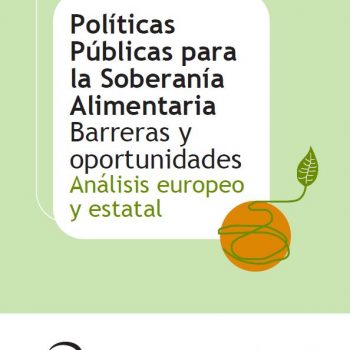Políticas públicas para la soberanía alimentaria: barreras y oportunidades. Análisis europeo y estatal
| Autor(es) |
Emaús Fundación Social |
| Título
| Políticas públicas para la soberanía alimentaria: barreras y oportunidades. Análisis europeo y estatal |
| Miniatura
|  |
| Fichero
| Soberania Alimentaria barreras y oportunidades |
| Tipo de recurso |
Monografía |
| Resumen |
Cuando se abordan las principales barreras legislativas a la producción campesina estatal, en
seguida aparecen algunas que tienen una clara raíz europea. Si habláramos de puertas cerradas
a la producción campesina, algunas de ellas son azules con estrellas amarillas y su llave está
en los bolsillos de alguna instancia europea. Este capítulo se dedica a ellas. Una barrera o una
puerta cerrada se pueden ver como un obstáculo pero al mismo tiempo como una oportunidad
de cambio. Identificarlas y determinar quién tiene su llave es, en realidad, un objetivo de lucha
y trabajo para la agricultura campesina.
En concreto este estudio agrupa las barreras (y las oportunidades) del estrato europeo en tres
grandes bloques:
La Política Agraria Común (PAC). En concreto dos de sus elementos:
-Ayudas a la agricultura.
-Políticas de intervención en los mercados agroalimentarios
Mal funcionamiento de la cadena alimentaria.
-Abusos de poder en la cadena.
-Legislación sobre Competencia.
Paquete higiénico/sanitario
Analizaremos cada uno de ellos y además se mostrarán dos aspectos que pensamos tienen
especial interés: la arquitectura legislativa, es decir, quién decide sobre qué para cada tema
y alguna de las fuerzas motrices que empujan en un sentido u otro. Los dos elementos extras
deberían ayudar a entender mejor como han surgido esas barreras y donde incidir para
derribarlas. |
| Summary |
When addressing the main legislative barriers to state-run peasant production, in Then there are some that have a clear European root. If we were to talk about closed doors production, some of them are blue with yellow stars and their key is
in the pockets of some European authority. This chapter is dedicated to them. A barrier or a
closed doors can be seen as an obstacle but at the same time as an opportunity of change. Identifying them and determining who has their key is really a struggle goal and I work for peasant agriculture.
Specifically, this study groups the barriers (and opportunities) of the European layer into three
large blocks:
The Common Agricultural Policy (CAP). Specifically two of its elements:
-Aid to agriculture.
-Intervention policies in agri-food markets
Malfunctioning food chain.
-Power abuse in the chain.
-Competition legislation.
Hygiene/sanitary package
We will analyze each one of them and also show two aspects that we think have special interest: the legislative architecture, i.e. who decides on what for each subject and some of the motive forces that push in one direction or another. The two extra elements should help to better understand how these barriers have arisen and where to go for
to knock them down.
|
| Palabras clave |
|
| Editorial |
Emaus Fundación Social |
| Lugar de edición |
Donostia San Sebastián |
| Notas |
Todos los derechos reservados Emaus Fundación Social. Original bajo Reconocimiento-No comercial-Compartir bajo la misma licencia 2.5 España |
